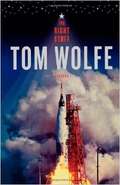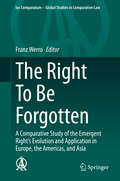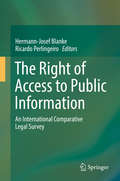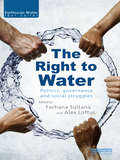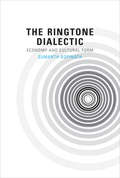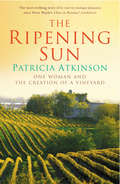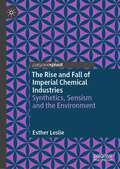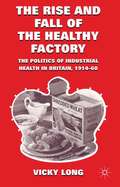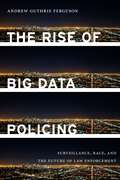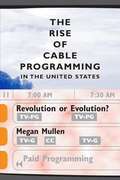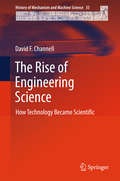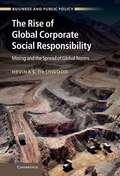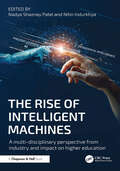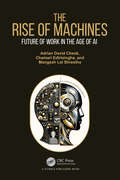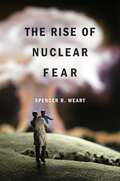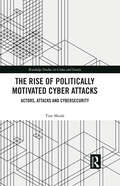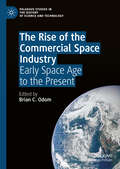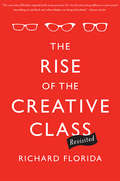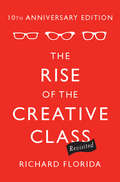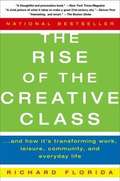- Table View
- List View
The Right Stuff
by Tom WolfeThe Right Stuff is Tom Wolfe's deft account of a cast of heroes, introduced to America with the explosion of space exploration in the romantic heyday of the 20th century and encapsulated in Neal Armstrong's "one giant step for mankind." <p><p>Beginning with the first experiments with manned space flight in the 1940s, remembering the feats of Chuck Yeager and the breaking of the sound barrier, and focusing in on the brave pilots of the Mercury Project, Wolfe's ability to marry historical fact with dramatic intensity is nowhere more evident than in The Right Stuff. <P><P> <B>Winner of the National Book Award</B>
The Right To Be Forgotten: A Comparative Study of the Emergent Right's Evolution and Application in Europe, the Americas, and Asia (Ius Comparatum - Global Studies in Comparative Law #40)
by Franz WerroThis book examines the right to be forgotten and finds that this right enjoys recognition mostly in jurisdictions where privacy interests impose limits on freedom of expression. According to its traditional understanding, this right gives individuals the possibility to preclude the media from revealing personal facts that are no longer newsworthy, at least where no other interest prevails. Cases sanctioning this understanding still abound in a number of countries. In today’s world, however, the right to be forgotten has evolved, and it appears in a more multi-faceted way. It can involve for instance also the right to access, control and even erase personal data. Of course, these prerogatives depend on various factors and competing interests, of both private and public nature, which again require careful balancing. Due to ongoing technological evolution, it is likely that the right to be forgotten in some of its new manifestations will become increasingly relevant in our societies.
The Right Way to Keep Chickens
by Virginia ShirtFor generations, people in the countryside have kept chickens, mainly for the eggs. Now, more and more people, in town as well as countryside, are enjoying the pleasure of keeping hens in the garden and reaping the reward of those fresh eggs every day. Virginia Shirt has lived with chickens for over 15 years so her knowledge of these fascinating birds is conditioned by practical experience. Her book is a revelation to every aspiring enthusiast. Concentrating initially on the very first steps, the book goes on to deal with feeding and rearing chickens and comprehensively covers matters relating to health and disease.
The Right Way to Keep Chickens
by Virginia ShirtFor generations, people in the countryside have kept chickens, mainly for the eggs. Now, more and more people, in town as well as countryside, are enjoying the pleasure of keeping hens in the garden and reaping the reward of those fresh eggs every day. Virginia Shirt has lived with chickens for over 15 years so her knowledge of these fascinating birds is conditioned by practical experience. Her book is a revelation to every aspiring enthusiast. Concentrating initially on the very first steps, the book goes on to deal with feeding and rearing chickens and comprehensively covers matters relating to health and disease.
The Right of Access to Public Information: An International Comparative Legal Survey
by Hermann-Josef Blanke Ricardo PerlingeiroThis book presents a comparative study on access to public information in the context of the main legal orders worldwide(inter alia China,France,Germany,Japan,Russia,Sweden,United States).The international team of authors analyzes the Transparency- and Freedom-to-Information legislation with regard to the scope of the right to access, limitations of this right inherent in the respective national laws, the procedure, the relationship with domestic legislation on administrative procedure, as well as judicial protection. It particularly focuses on the Brazilian law establishing the right of access to information, which is interpreted as a benchmark for regulations in other Latin-American states.
The Right to Fly
by George Sand Felix NadarA book passionately defending balloon flight for human beings, celebrating the 175th anniversary of The London Library.The first balloon flight with passengers (a sheep, a duck, and a rooster) took place on 19th September 1783. On 4th October 1863, Nadar's giant balloon "Le Géant" had its first ascent; the second (and nearly fatal) was two weeks later.A curiosity both for its content on theories of flight and its author, an important pioneer of French photography and skilled self-publicist, The Right to Fly indicates the interest taken by many at the time in the possibilities of human flight - and the Victorian passion for discoveries and invention.The books in "Found on the Shelves" have been chosen to give a fascinating insight into the treasures that can be found while browsing in The London Library. Now celebrating its 175th anniversary, with over seventeen miles of shelving and more than a million books, The London Library has become an unrivalled archive of the modes, manners and thoughts of each generation which has helped to form it.From essays on dieting in the 1860s to instructions for gentlewomen on trout-fishing, from advice on the ill health caused by the "modern" craze of bicycling to travelogues from Norway, they are as readable and relevant today as they were more than a century ago.
The Right to Oblivion: Privacy and the Good Life
by Lowry PresslyA visionary reexamination of the value of privacy in today’s hypermediated world—not just as a political right but as the key to a life worth living.The parts of our lives that are not being surveilled and turned into data diminish each day. We are able to configure privacy settings on our devices and social media platforms, but we know our efforts pale in comparison to the scale of surveillance capitalism and algorithmic manipulation. In our hyperconnected era, many have begun to wonder whether it is still possible to live a private life, or whether it is no longer worth fighting for.The Right to Oblivion argues incisively and persuasively that we still can and should strive for privacy, though for different reasons than we might think. Recent years have seen heated debate in the realm of law and technology about why privacy matters, often focusing on how personal data breaches amount to violations of individual freedom. Yet as Lowry Pressly shows, the very terms of this debate have undermined our understanding of privacy’s real value. In a novel philosophical account, Pressly insists that privacy isn’t simply a right to be protected but a tool for making life meaningful.Privacy deepens our relationships with others as well as ourselves, reinforcing our capacities for agency, trust, play, self-discovery, and growth. Without privacy, the world would grow shallow, lonely, and inhospitable. Drawing inspiration from the likes of Hannah Arendt, Jorge Luis Borges, and a range of contemporary artists, Pressly shows why we all need a refuge from the world: not a place to hide, but a psychic space beyond the confines of a digital world in which the individual is treated as mere data.
The Right to Water: Politics, Governance and Social Struggles (Earthscan Water Text)
by Alex Loftus Farhana SultanaThe right to clean water has been adopted by the United Nations as a basic human right. Yet how such universal calls for a right to water are understood, negotiated, experienced and struggled over remain key challenges. The Right to Water elucidates how universal calls for rights articulate with local historical geographical contexts, governance, politics and social struggles, thereby highlighting the challenges and the possibilities that exist. Bringing together a unique range of academics, policy-makers and activists, the book analyzes how struggles for the right to water have attempted to translate moral arguments over access to safe water into workable claims. This book is an intervention at a crucial moment into the shape and future direction of struggles for the right to water in a range of political, geographic and socio-economics contexts, seeking to be pro-active in defining what this struggle could mean and how it might be taken forward in a far broader transformative politics. The Right to Water engages with a range of approaches that focus on philosophical, legal and governance perspectives before seeking to apply these more abstract arguments to an array of concrete struggles and case studies. In so doing, the book builds on empirical examples from Africa, Asia, Oceania, Latin America, the Middle East, North America and the European Union.
The Ringtone Dialectic: Economy and Cultural Form
by Sumanth GopinathThe rise and fall of the ringtone industry and its effect on mobile entertainment, music, television, film, and politics.A decade ago, the customizable ringtone was ubiquitous. Almost any crowd of cell phone owners could produce a carillon of tinkly, beeping, synthy, musicalized ringer signals. Ringtones quickly became a multi-billion-dollar global industry and almost as quickly faded away. In The Ringtone Dialectic, Sumanth Gopinath charts the rise and fall of the ringtone economy and assesses its effect on cultural production.Gopinath describes the technical and economic structure of the ringtone industry, considering the transformation of ringtones from monophonic, single-line synthesizer files to polyphonic MIDI files to digital sound files and the concomitant change in the nature of capital and rent accumulation within the industry. He discusses sociocultural practices that seemed to wane as a result of these shifts, including ringtone labor, certain forms of musical notation and representation, and the creation of musical and artistic works quoting ringtones. Gopinath examines “declines,” “reversals,” and “revivals” of cultural forms associated with the ringtone and its changes, including the Crazy Frog fad, the use of ringtones in political movements (as in the Philippine “Gloriagate” scandal), the ringtone's narrative function in film and television (including its striking use in the films of the Chinese director Jia Zhangke), and the ringtone's relation to pop music (including possible race and class aspects of ringtone consumption). Finally, Gopinath considers the attempt to rebrand ringtones as “mobile music” and the emergence of cloud computing.
The Ripening Sun
by Patricia AtkinsonFor most people giving up the day job and moving to a beautiful area of France and living off the vines is an impossible but delicious dream. In 1990, Patricia Atkinson and her husband decided to sell up in Britain and emigrate to the Dordogne. Their idea was to buy a house with a few vines attached and employ someone to tend to the wine while they earned their living with some financial consultancy work. There followed a series of disasters: the stock market crashed leaving their small holding as their sole source of income; the first red wine harvest turned to vinegar; and Patricia's husband returned to Britain, unable to cope with the stress. He never returned. Patricia Atkinson, whose only knowledge of wine up to that moment was 'that it came from a bottle' and who had not a word of French, was left to salvage their life savings form the vineyards. What follows is a remarkable story of struggle and transformation whereby her tiny 4 hectare plot has become a major estate of 21 hectares, where her Clos d'Yvigne wines have won awards and been adopted by wine merchants throughout the world and where she has been hailed as a superstar by UK wine writers.
The Rise and Fall of Imperial Chemical Industries: Synthetics, Sensism and the Environment
by Esther LeslieThis book provides a history of Imperial Chemical Industries (ICI), a large Britain- based chemical firm which was a major industrial player in the twentieth century. Once a model for Britain’s industrial reach and dominance, ICI collapsed in the mid-2000s, with some still profitable elements sold off to other chemical firms. The book focuses on the firm’s origin site in the Northeast of England, around Middlesbrough, engaging the remnants of the company magazine, oral histories and social media posts, and material artifacts in the world, to relate a history of the social, environmental, cultural and imaginative and bodily impact of the presence (and then absence) of ICI. This unique work is open to coincidence and speculation, drawing on science fictional and urban myth narratives which emanate from the area. Through the lens of global narratives of industrial and philosophical innovation, it inquires into uncommon and diverse themes, such as the manufacture of Quorn, the place of photographic mediation of the factory, and industrial disease. Setting out from a context of heavy industry and material processing, the book seeks to stimulate poetic and creative thinking around the ways in which people’s lives were enmeshed with synthetic chemicals and the dreams that seemed to ooze and seep from them as by-products.
The Rise and Fall of the Healthy Factory
by Vicky LongThe first account of the emergence and demise of preventive health care for workers. It explores how trade unions, employers, doctors and the government reconfigured the relationship between health, productivity and the factory over the course of the twentieth century within a broader political, industrial and social context.
The Rise of Big Data Policing: Surveillance, Race, and the Future of Law Enforcement (Goldstein-Goren American Jewish History)
by Andrew Guthrie FergusonPROSE Award Winner in Law & Legal Studies:&“Essential reading for anyone who wants to understand how technology is changing American policing.&” —Kirkus Reviews (starred review) In a command center in downtown Los Angeles, a digital map lights up with 911 calls, TV monitors track breaking news, surveillance cameras sweep the streets, and rows of computers link analysts and police officers to a wealth of intelligence. This is just a glimpse into a future where software predicts crimes, algorithms generate &“most-wanted&” lists, and databanks collect personal and biometric information. The Rise of Big Data Policing introduces the cutting-edge technology that is changing how the police do their jobs and shows why it is crucial that citizens understand the far-reaching consequences of big data surveillance as a law enforcement tool. Andrew Guthrie Ferguson reveals how these technologies —viewed as race-neutral and objective—have been eagerly adopted by police departments hoping to distance themselves from claims of racial bias and unconstitutional practices. After a series of high-profile police shootings and federal investigations into systemic misconduct, and in an era of law enforcement budget cutbacks, data-driven policing has been billed as a way to turn the page on racial bias. But behind the data are real people, and difficult questions remain. This groundbreaking book examines how new technologies will alter who, where, when, and how we police, and how they also offer data-driven methods to improve police accountability—and remedy underlying socio-economic risk factors that encourage crime. It is a must read for understanding how technology will revolutionize law enforcement—and its potential threat to the security, privacy, and constitutional rights of citizens. &“Ferguson teaches us not only the fault lines in how police watch us, but how we can turn the tables to use new algorithms to watch the police. At stake is nothing less than individual liberty and the democratic control of policing.&”—Jeffrey Fagan, Isidor and Seville Sulzbacher Professor of Law, Columbia University &“Ferguson has an incredible command of the many subjects that fall under the &‘big data&’ umbrella.&”—Gizmodo &“Will be indispensable to [anyone] interested in the practice of policing.&”—Library Journal
The Rise of Cable Programming in the United States: Revolution or Evolution?
by Megan MullenIn 1971, the Sloan Commission on Cable Communications likened the ongoing developments in cable television to the first uses of movable type and the invention of the telephone. <P><P>Cable's proponents in the late 1960s and early 1970s hoped it would eventually remedy all the perceived ills of broadcast television, including lowest-common-denominator programming, inability to serve the needs of local audiences, and failure to recognize the needs of cultural minorities. Yet a quarter century after the "blue sky" era, cable television programming closely resembled, and indeed depended upon, broadcast television programming. Whatever happened to the Sloan Commission's "revolution now in sight"?
The Rise of Engineering Science: How Technology Became Scientific (History of Mechanism and Machine Science #35)
by David F. ChannellThe 18th and 19th centuries saw the emergence of new intermediary types of knowledge in areas such as applied mechanics, fluid mechanics and thermodynamics, which came to be labeled as engineering science, transforming technology into the scientific discipline that we know today. This book analyzes how the Scientific Revolution of the 16th and 17th centuries and the Industrial Revolution of the 18th and 19th centuries provided the intellectual, social, economic and institutional foundations for the emergence of engineering science. The book then traces the rise of engineering science from the 18th century through the 19th century and concludes by showing how it led to new technological developments in such areas as steel production, the invention of internal combustion engines, the creation of automobiles and airplanes, and the formulation of Mass Production and Scientific Management all of which brought about major transformations in the materials, power sources, transportation and production techniques that have come to shape our modern world.
The Rise of Global Corporate Social Responsibility
by Hevina S. DashwoodCombining insights from international relations theory with institutional approaches from organization theory and public policy, this book provides a complete explanation for the adoption of Corporate Social Responsibility (CSR), showing how global norms influenced CSR adoption in the mining industry. Global normative developments have clearly had an important influence on major mining companies: by the mid 2000s the majority had adopted sustainable development as a normative frame for their CSR policies and practices. However, there is significant variation between firms in terms of the timing, degree of commitment and the willingness to assume a leadership role in promoting global standards for the mining industry. The author finds that attributes internal to the firm, including the critical role of leadership, and the way in which management responds to the institutional context and operational challenges faced in different countries are important influences on CSR adoption and important factors explaining variation.
The Rise of Intelligent Machines: A Multi-disciplinary Perspective from Industry and Impact on Higher Education
by Nitin IndurkhyaA fascinating shift marks the journey of technological evolution. Historically, humans were trained to build and operate machines. This education emphasised mechanical skills, logical thinking, and problem-solving abilities, laying the groundwork for the following industrial revolutions. Early machines, from the steam engine to the assembly line, were designed and maintained by skilled human workers, reflecting a one-way relationship where humans were the creators and controllers of machines.Today, we stand on the brink of a new paradigm. Advanced artificial intelligence (AI) systems and generative AI tools are not just aiding human tasks but are also capable of educating and guiding humans. These intelligent machines can analyse vast amounts of data, provide personalised learning experiences, and generate creative content. The transformation from humans building machines to machines educating humans signifies a profound shift in our technological landscape, impacting industries.As editors, we are united by a profound conviction that bridging the gap between industry and higher education is imperative in the face of rapid advancements in generative AI and innovations across various industries. This connection is crucial to equipping graduates and young professionals with the skills to innovate and excel in the future workforce. Through this multidisciplinary exploration, The Rise of Intelligent Machines aims to provide readers with an understanding of AI's transformative potential and the strategies needed to harness its benefits for industry and education.Every chapter reflects our shared passion for AI’s potential and close industry-higher education collaboration, and we hope that our work inspires you to embrace the opportunities and challenges of the future with curiosity and confidence.
The Rise of Machines: Future of Work in the Age of AI
by Adrian David Cheok Chamari Edirisinghe Mangesh Lal ShresthaThis book provides an in-depth look at the impact of artificial intelligence (AI) on the future of work. The rise of AI and automation is transforming the world of work, and the book explores the implications of this transformation on jobs and skills. It begins by introducing readers to the basics of AI technology and its various applications in the workplace. It then moves on to examine the impact of AI on jobs and skills, including the changing nature of work and the potential for job loss due to automation. It also delves into the ethical implications of AI in the workplace, including the moral and ethical questions that arise when AI is used to make decisions that affect people's lives.Besides exploring the impact of AI on the workforce, the book provides practical advice for preparing for the future of work in the age of AI. This includes the importance of reskilling and upskilling, as well as strategies for adapting to the changing world of work in the age of AI. It concludes with a future outlook, exploring the likely direction of the workforce in the years to come and the importance of preparing for the future with a proactive approach to AI and the workforce. This book provides a comprehensive and accessible look at the impact of AI on the future of work. It is ideal for anyone interested in understanding the implications of AI on the workforce and preparing for the future of work in the age of AI.
The Rise of Nuclear Fear
by Spencer R. WeartAfter a tsunami destroyed the cooling system at Japan's Fukushima Nuclear Power Plant, triggering a meltdown, protesters around the world challenged the use of nuclear power. Germany announced it would close its plants by 2022. Although the ills of fossil fuels are better understood than ever, the threat of climate change has never aroused the same visceral dread or swift action. Spencer Weart dissects this paradox, demonstrating that a powerful web of images surrounding nuclear energy holds us captive, allowing fear, rather than facts, to drive our thinking and public policy. Building on his classic, Nuclear Fear, Weart follows nuclear imagery from its origins in the symbolism of medieval alchemy to its appearance in film and fiction. Long before nuclear fission was discovered, fantasies of the destroyed planet, the transforming ray, and the white city of the future took root in the popular imagination. At the turn of the twentieth century when limited facts about radioactivity became known, they produced a blurred picture upon which scientists and the public projected their hopes and fears. These fears were magnified during the Cold War, when mushroom clouds no longer needed to be imagined; they appeared on the evening news. Weart examines nuclear anxiety in sources as diverse as Alain Resnais's film Hiroshima Mon Amour, Cormac McCarthy's novel The Road, and the television show The Simpsons. Recognizing how much we remain in thrall to these setpieces of the imagination, Weart hopes, will help us resist manipulation from both sides of the nuclear debate.
The Rise of Politically Motivated Cyber Attacks: Actors, Attacks and Cybersecurity (Routledge Studies in Crime and Society)
by Tine MunkThis book outlines the complexity in understanding different forms of cyber attacks, the actors involved, and their motivations. It explores the key challenges in investigating and prosecuting politically motivated cyber attacks, the lack of consistency within regulatory frameworks, and the grey zone that this creates, for cybercriminals to operate within. Connecting diverse literatures on cyberwarfare, cyberterrorism, and cyberprotests, and categorising the different actors involved – state-sponsored/supported groups, hacktivists, online protestors – this book compares the means and methods used in attacks, the various attackers, and the current strategies employed by cybersecurity agencies. It examines the current legislative framework and proposes ways in which it could be reconstructed, moving beyond the traditional and fragmented definitions used to manage offline violence. This book is an important contribution to the study of cyber attacks within the areas of criminology, criminal justice, law, and policy. It is a compelling reading for all those engaged in cybercrime, cybersecurity, and digital forensics.
The Rise of the Commercial Space Industry: Early Space Age to the Present (Palgrave Studies in the History of Science and Technology)
by Brian C. OdomThis collection explores the evolution of the commercial space industry from the beginning of the space age through the early twenty-first century. Today, the space industry is taking on an increased leadership and innovation role in both space access and exploration. The growth of commercial space over the past decades offers a potential new paradigm for space exploration – one in which industry transitions from supplier to partner. However, many questions remain. This book seeks to bring to light these questions, which span from the most seemingly consequential: how will humanity explore the Moon and Mars? - to the most basic: what is commercial space? To further develop the historical context of commercial space, and thereby better inform decision-making at NASA in the future, this volume examines a broad range of questions related to the history of commercial space operations, including but not limited to: how has the concept of ‘commercial space’ evolved in different fields and disciplines? What have been the major events and milestones in the emergence and evolution of commercial space activities in the USA and internationally? How has the US Government assisted or impeded the emergence and evolution of commercial space activities? Providing contributions from a range of different disciplines and backgrounds, the authors of this volume offer valuable insights for scholars researching the history of space and space policy, as well as decision-makers working at NASA or within the wider space industry.
The Rise of the Creative Class, Revisited
by Richard FloridaInitially published in 2002, The Rise of the Creative Class quickly achieved classic status for its identification of forces then only beginning to reshape our economy, geography, and workplace. Weaving story-telling with original research, Richard Florida identified a fundamental shift linking a host of seemingly unrelated changes in American society: the growing importance of creativity in people’s work lives and the emergence of a class of people unified by their engagement in creative work. Millions of us were beginning to work and live much as creative types like artists and scientists always had, Florida observed, and this Creative Class was determining how the workplace was organized, what companies would prosper or go bankrupt, and even which cities would thrive. In The Rise of the Creative Class Revisited, Florida further refines his occupational, demographic, psychological, and economic profile of the Creative Class, incorporates a decade of research, and adds five new chapters covering the global effects of the Creative Class and exploring the factors that shape "quality of place” in our changing cities and suburbs.
The Rise of the Creative Class--Revisited
by Richard FloridaThe Washington Monthly 2002 Annual Political Book Award WinnerThe Rise of the Creative Class gives us a provocative new way to think about why we live as we do today-and where we might be headed. Weaving storytelling with masses of new and updated research, Richard Florida traces the fundamental theme that runs through a host of seemingly unrelated changes in American society: the growing role of creativity in our economy. Just as William Whyte's 1956 classic The Organization Man showed how the organizational ethos of that age permeated every aspect of life, Florida describes a society in which the creative ethos is increasingly dominant. Millions of us are beginning to work and live much as creative types like artists and scientists always have-with the result that our values and tastes, our personal relationships, our choices of where to live, and even our sense and use of time are changing. Leading the shift are the nearly 38 million Americans in many diverse fields who create for a living-the Creative Class. The Rise of the Creative Class chronicles the ongoing sea of change in people's choices and attitudes, and shows not only what's happening but also how it stems from a fundamental economic change. The Creative Class now comprises more than thirty percent of the entire workforce. Their choices have already had a huge economic impact. In the future they will determine how the workplace is organized, what companies will prosper or go bankrupt, and even which cities will thrive or wither.
The Rise of the Creative Class: And How It's Transforming Work, Leisure, Community and Everyday Life
by Richard L. FloridaThe Rise of the Creative Class gives a provocative way to think about why people live as they do today and where they might be headed. Weaving storytelling with masses of new and updated research, Florida traces the role of creativity in the economy.
The Rise of the Intelligent Health System (Intelligent Health Series)
by Harry P. Pappas Paul H. Frisch"I recommend that all members of the health community read this book to obtain a real snapshot of how the Intelligent Health System is being transformed via new technologies." Chris Landon MD FAAP, FCCP, FRSM Clinical Associate Professor USC Keck School of Medicine Technology Development Center Laboratory and Studio The "Intelligent Health Pavilion" as demonstrated at the annual HIMSS Conference by the Intelligent Health Association is the impetus for this book. This book documents the remarkable journey of "Intelligent Health System" and the adoption of Innovative technologies. Many showcased in real time on the trade show floor and now in this book: "The Rise of the Intelligent Health System". In each chapter of this book, authors are expressing the immense potential of merging cutting-edge technology with the complex realm of patient care and safety. The informative chapters in this book delve deep into the unfolding story of how hospitals have evolved into interactive, intelligent environments, driven by real-time data and powered by artificial intelligence. In what seems like the blink of an eye, technology has completely transformed the way we live, work, and interact with the world around us. From smartphones to self-driving cars, ChatGPT, wireless technologies, wearables, and many other innovations are reshaping our society, pushing the boundaries of what was once considered impossible. However, nowhere is the impact of technology more profound than in the field of healthcare.
